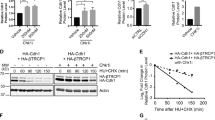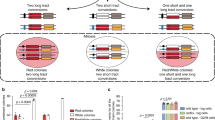Abstract
The cellular response to the introduction of double strand DNA breaks involves complexes of protein interactions that govern cell cycle checkpoint arrest and repair of the DNA lesions. The checkpoint kinases Chk1 and Chk2 phosphorylate the carboxy-terminal domain of hBRCA2, a protein involved in recombination-mediated DNA repair (HRR) and replication fork maintenance. Cells deficient in hBRCA2 are hypersensitive to DNA damaging agents. Phosphorylation of the residue in hBRCA2 targeted by the Chk1 and Chk2 kinases regulates its interaction with Rad51. Furthermore, the cell line lex1/lex2, which lacks the carboxy-terminal domain containing the phosphorylated residue, does not support localization of Rad51 to nuclear foci after exposure to UV or treatment with ionizing radiation (IR). The data show that either phosphorylation of Rad51 by Chk1 or phosphorylation of the carboxy-terminal domain of hBRCA2 by Chk1 or Chk2 plays a critical role in the binding of Rad51 to hBRCA2 and the subsequent recruitment of Rad51 to sites of DNA damage. While depletion of Chk1 from cells leads to loss of Rad51 localization to nuclear foci in response to replication arrest, cells lacking Chk2 also show a defect in Rad51 localization, but only in presence of double strand DNA breaks, indicating that each of these kinases may contribute somewhat differently to the formation of Rad51 nucleoprotein filaments depending on the type of DNA damage incurred by the cells.
This is a preview of subscription content, access via your institution
Access options
Subscribe to this journal
Receive 50 print issues and online access
$259.00 per year
only $5.18 per issue
Buy this article
- Purchase on Springer Link
- Instant access to full article PDF
Prices may be subject to local taxes which are calculated during checkout






Similar content being viewed by others
Abbreviations
- Chk1:
-
checkpoint protein 1
- Chk2:
-
checkpoint protein 2
- IR:
-
ionizing radiation
- SiRNA:
-
small interference RNA
- HR:
-
homologous recombination
References
Bahassi EM, Penner CG, Robbins S, Tichy E, Feliciano E, Yin M et al. (2007). The breast cancer susceptibility allele CHEK2*1100delC promotes genomic instability in a knock-in mouse model. Mutat Res 616: 201–209.
Baumann P, Benson FE, West SC . (1996). Human Rad51 protein promotes ATP-dependent homologous pairing and strand transfer reactions in vitro. Cell 87: 757–766.
Bork P, Blomberg N, Nilges M . (1996). Internal repeats in the BRCA2 protein sequence. Nat Genet 13: 22–23.
Davies A, Masson J, McIlwraith M, Stasiak AZ, Stasiak A, Venkitaraman AR et al. (2001). Role of BRCA2 in control of the RAD51 recombination and DNA repair protein. Mol Cell 7: 273–282.
Donoho G, Brenneman M, Cui TX, Donoviel D, Vogel H, Goodwin EH et al. (2003). Deletion of Brca2 exon 27 causes hypersensitivity to DNA crosslinks, chromosomal instability, and reduced life span in mice. Genes Chromosomes Cancer 36: 317–331.
Esashi F, Christ N, Gannon J, Liu Y, Hunt T, Jasin M et al. (2005). CDK-dependent phosphorylation of BRCA2 as a regulatory mechanism for recombinational repair. Nature 434: 598–604.
Mizuta R, LaSalle JM, Cheng HL, Shinohara A, Ogawa H, Copeland N et al. (1997). RAB22 and RAB163/mouse BRCA2: proteins that specifically interact with the RAD51 protein. Proc Natl Acad Sci USA 94: 6927–6932.
Moynahan M, Pierce A, Jasin M . (2001). BRCA2 is required for homology-directed repair of chromosomal breaks. Mol Cell 7: 263–272.
Pellegrini L, Yu DS, Lo T, Anand S, Lee M, Blundell TL et al. (2002). Insights into DNA recombination from the structure of a RAD51–BRCA2 complex. Nature 420: 287–293.
Ponder BAJ, Day NE, Easton DF, Pharoah PDP . (2000). Prevalence and penetrance of BRCA1 and BRCA2 mutations in a population-based series of breast cancer cases. Br J Cancer 83: 1301–1308.
Sharan SK, Morimatsu M, Albrecht U, Lim DS, Regel E, Dinh C et al. (1997). Embryonic lethality and radiation hypersensitivity mediated by Rad51 in mice lacking Brca2. Nature 386: 804–810.
Shivji MK, Davies OR, Savill JM, Bates DL, Pellegrini L, Venkitaraman AR . (2006). A region of human BRCA2 containing multiple BRC repeats promotes RAD51-mediated strand exchange. Nucleic Acids Res 34: 4000–4011.
Sorensen CS, Hansen LT, Dziegielewski J, Syljuåsen RG, Lundin C, Bartek J et al. (2005). The cell-cycle checkpoint kinase Chk1 is required for mammalian homologous recombination repair. Nat Cell Biol 7: 195–201.
Venkitaraman AR . (2000). The breast cancer susceptibility gene, BRCA2: at the crossroads between DNA replication and recombination? Philos Trans R Soc Lond B Biol Sci 355: 191–198.
Venkitaraman AR . (2002). Cancer susceptibility and the functions of BRCA1 and BRCA2. Cell 2: 171–182.
Welcsh PL, King MC . (2001). BRCA1 and BRCA2 and the genetics of breast and ovarian cancer. Hum Mol Genet 10: 705–713.
Wong AK, Pero R, Ormonde PA, Tavtigian SV, Bartel PL . (1997). RAD51 interacts with the evolutionarily conserved BRC motifs in the human breast cancer susceptibility gene brca2. J Biol Chem 272: 31941–31944.
Xia F, Taghian DG, DeFrank JS, Zeng ZC, Willers H, Iliakis G et al. (2001). Deficiency of human BRCA2 leads to impaired homologous recombination but maintains normal non-homologous end-joining. Proc Natl Acad Sci USA 98: 8644–8649.
Yu VP, Koehler M, Steinlein C, Schmid M, Hanakahi LA, van Gool AJ et al. (2000). Gross chromosomal rearrangements and genetic exchange between non-homologous chromosomes following BRCA2 inactivation. Genes Dev 14: 1400–1406.
Acknowledgements
This work was supported in part by NIEHS grant no. P30-ES06096 and NIH grants U02 ES011038, CA 90934 and P39-ES06096.
Author information
Authors and Affiliations
Corresponding author
Rights and permissions
About this article
Cite this article
Bahassi, E., Ovesen, J., Riesenberg, A. et al. The checkpoint kinases Chk1 and Chk2 regulate the functional associations between hBRCA2 and Rad51 in response to DNA damage. Oncogene 27, 3977–3985 (2008). https://doi.org/10.1038/onc.2008.17
Received:
Revised:
Accepted:
Published:
Issue Date:
DOI: https://doi.org/10.1038/onc.2008.17
Keywords
This article is cited by
-
In Silico design and characterization of RAD51 protein inhibitors targeting homologous recombination repair for cancer therapy
Genome Instability & Disease (2023)
-
Roles of Claspin in regulation of DNA replication, replication stress responses and oncogenesis in human cells
Genome Instability & Disease (2021)
-
Participation of the ATR/CHK1 pathway in replicative stress targeted therapy of high-grade ovarian cancer
Journal of Hematology & Oncology (2020)
-
Comparison of the different mechanisms of cytotoxicity induced by checkpoint kinase I inhibitors when used as single agents or in combination with DNA damage
Oncogene (2020)
-
ATM activity in T cells is critical for immune surveillance of lymphoma in vivo
Leukemia (2020)



